Abstract
Chemotherapy, in conjunction with other methods of treatment, was used in 100 patients with invasive hydatidiform mole or choriocarcinoma following mole. When treatment was instituted within two to six months of the antecedent mole serious drug resistance was not encountered, drug toxicity was slight, the duration of treatment was comparatively short, and sustained remissions were obtained in 57 out of 60 patients. When the start of chemotherapy was delayed beyond six months drug resistance occurred in many instances, toxicity was often severe, the duration of treatment was much longer, and sustained remissions were obtained in 22 out of 40 patients.
The practice of giving prophylactic chemotherapy to all patients with mole is not established as effective or safe. Differences in the social background to hydatidiform mole in different geographical areas may be such that conclusions based on evidence from one area are not necessarily applicable to another.
Careful follow-up after mole remains essential, though present methods often fail to ensure recognition of choriocarcinoma while it is still curable. Standard qualitative and quantitative methods for detecting the continued excretion of chorionic gonadotrophin, though useful, are sometimes too insensitive. It is suggested that to supplement local arrangements some form of centralized or regionalized follow-up service based on notification of patients with hydatidiform mole, and making use of radioimmunoassays for chorionic gonadotrophin, could reduce deaths attributable to late diagnosis.
Full text
PDF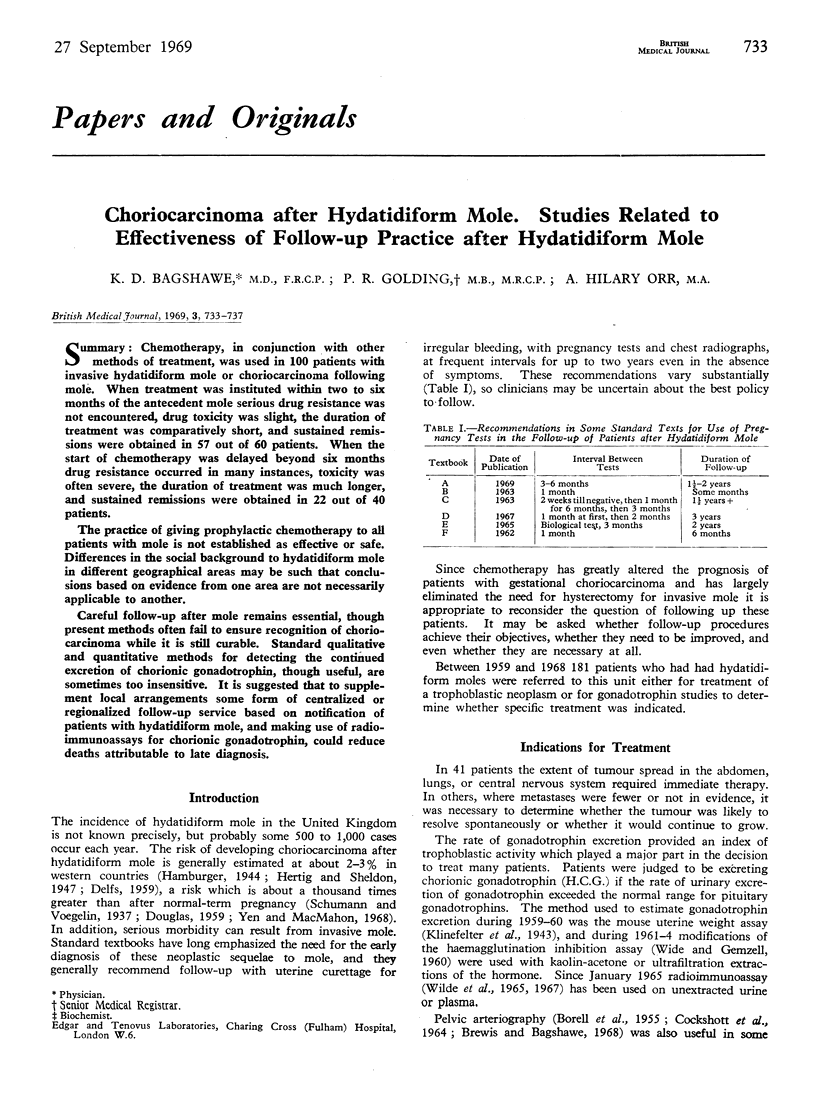
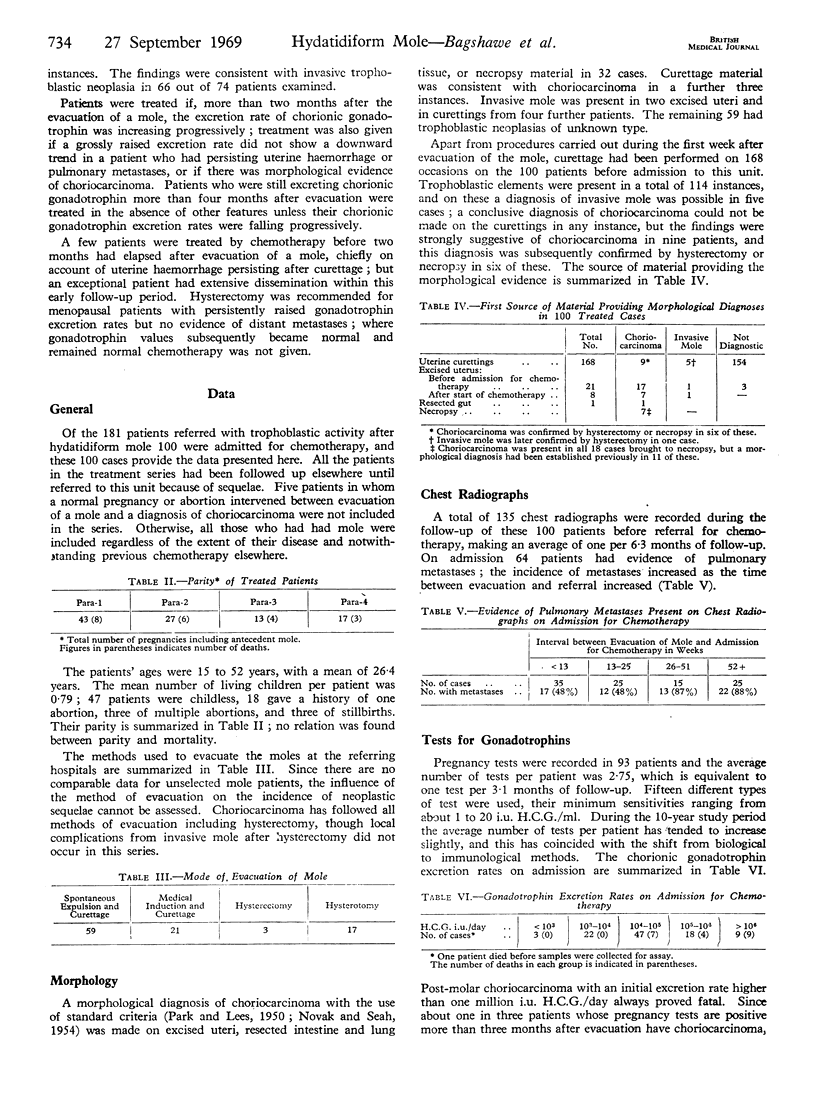
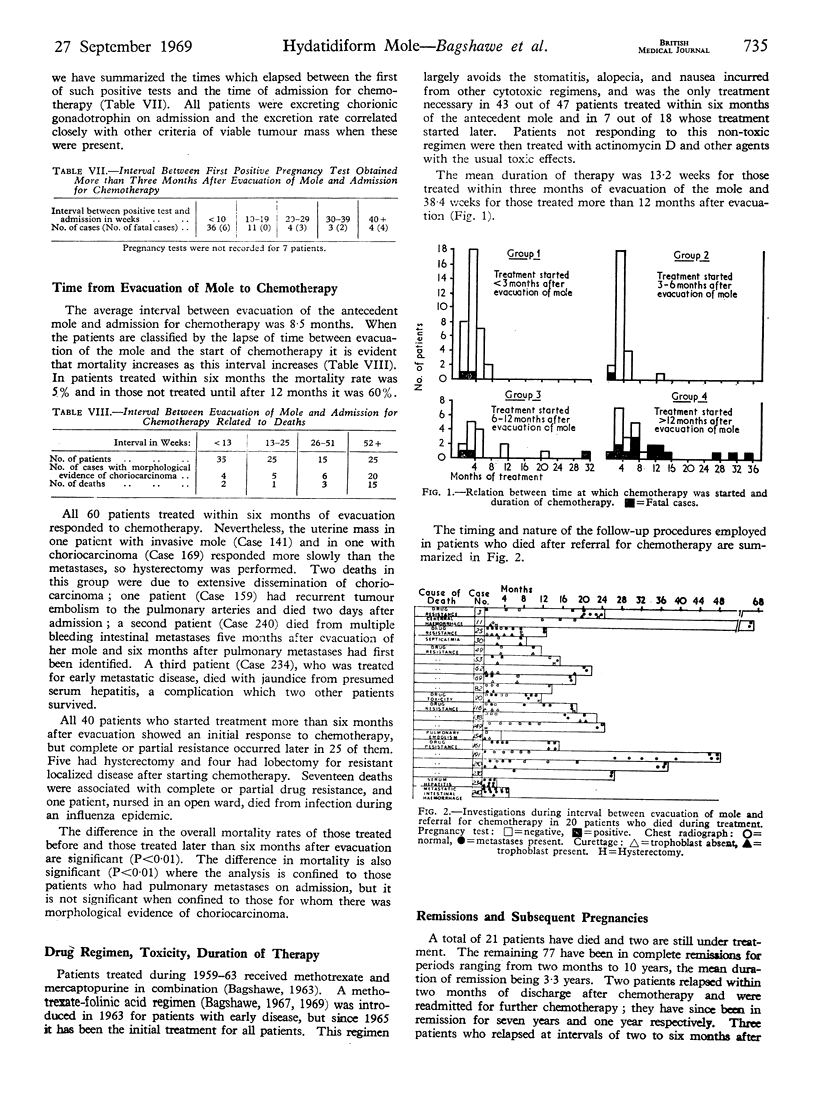
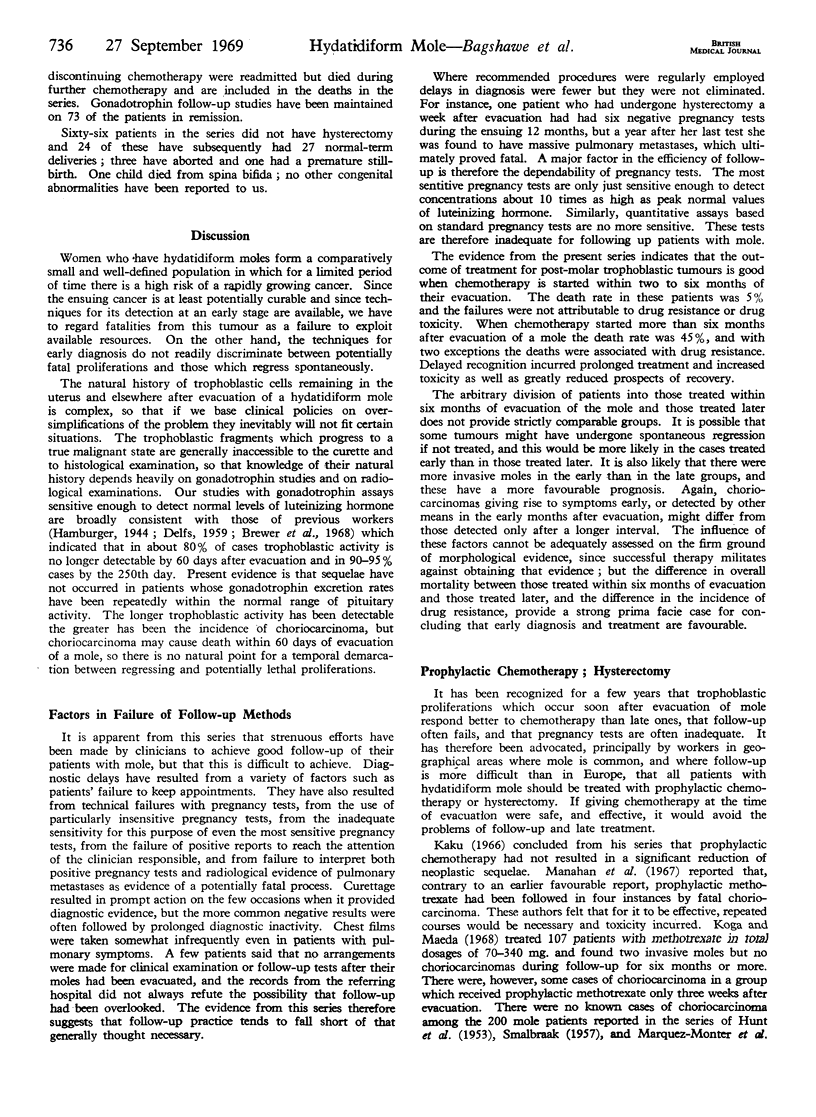
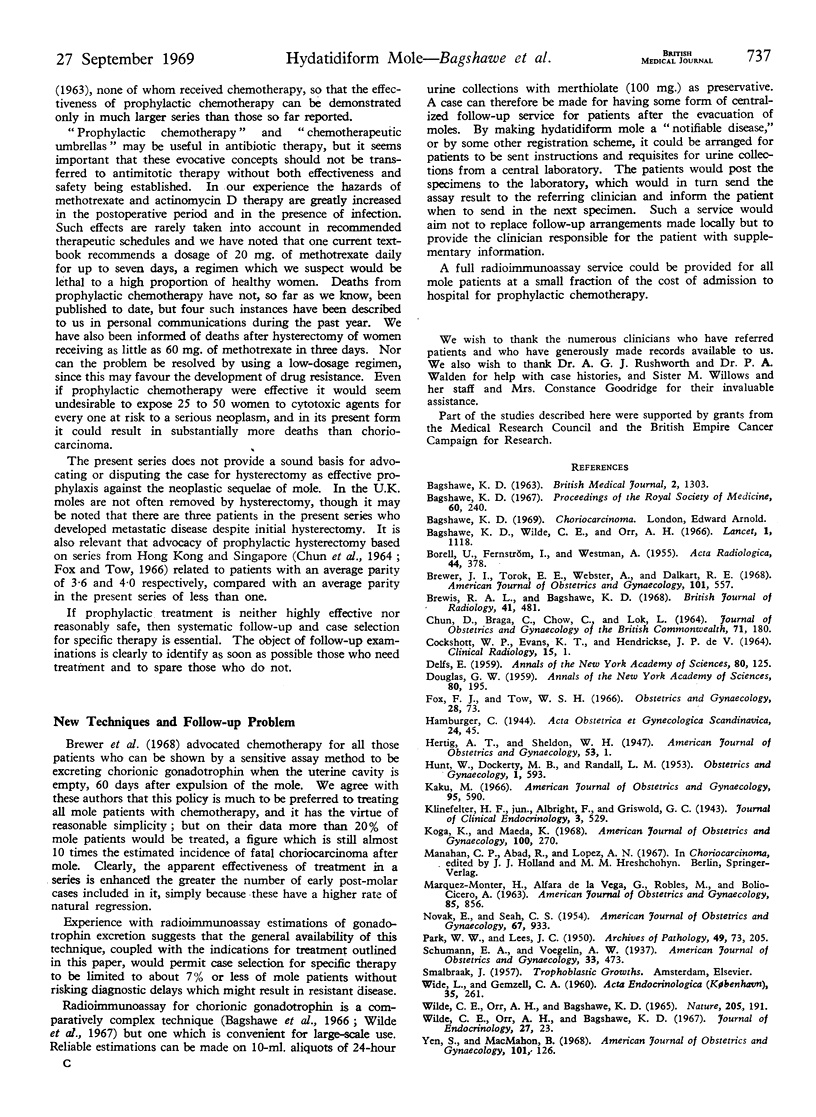
Selected References
These references are in PubMed. This may not be the complete list of references from this article.
- BORELL U., FERNSTROM I., WESTMAN A. The value of pelvic arteriography in the diagnosis of mole and chorionepithelioma. Acta radiol. 1955 Nov;44(5):378–384. doi: 10.3109/00016925509171299. [DOI] [PubMed] [Google Scholar]
- Bagshawe K. D. Gonadotrophin excretion, pelvic arteriography and treatment in post-molar trophoblastic disease. Proc R Soc Med. 1967 Mar;60(3):240–242. [PMC free article] [PubMed] [Google Scholar]
- Bagshawe K. D., Wilde C. E., Orr A. H. Radioimmunoassay for human chorionic gonadotrophin and luteinising hormone. Lancet. 1966 May 21;1(7447):1118–1121. doi: 10.1016/s0140-6736(66)91136-6. [DOI] [PubMed] [Google Scholar]
- Brewer J. I., Torok E. E., Webster A., Dolkart R. E. Hydatidiform mole. A follow-up regimen for identification of invasive mole and choriocarcinoma and for selection of patients for treatment. Am J Obstet Gynecol. 1968 Jun 15;101(4):557–563. [PubMed] [Google Scholar]
- Brewis R. A., Bagshawe K. D. Pelvic arteriography in invasive trophoblastic neoplasia. Br J Radiol. 1968 Jul;41(487):481–495. doi: 10.1259/0007-1285-41-487-481. [DOI] [PubMed] [Google Scholar]
- CHUN D., BRAGA C., CHOW C., LOK L. CLINICAL OBSERVATIONS ON SOME ASPECTS OF HYDATIDIFORM MOLES. J Obstet Gynaecol Br Commonw. 1964 Apr;71:180–184. doi: 10.1111/j.1471-0528.1964.tb04263.x. [DOI] [PubMed] [Google Scholar]
- COCKSHOTT W. P., EVANS K. T., HENDRICKSE J. P. ARTERIOGRAPHY OF TROPHOBLASTIC TUMOURS. Clin Radiol. 1964 Jan;15:1–8. doi: 10.1016/s0009-9260(64)80043-x. [DOI] [PubMed] [Google Scholar]
- DELFS E. Chorionic gonadotrophin determinations in patients with hydatidiform mole and choriocarcinoma. Ann N Y Acad Sci. 1959 Aug 28;80:125–139. doi: 10.1111/j.1749-6632.1959.tb49199.x. [DOI] [PubMed] [Google Scholar]
- Fox F. J., Jr, Tow W. S. Immunologically determined chorionic gonadotrophin levels in Singapore women with hydatidiform mole. Obstet Gynecol. 1966 Jul;28(1):73–85. [PubMed] [Google Scholar]
- HUNT W., DOCKERTY M. B., RANDALL L. M. Hydatiform mole; a clinicopathologic study involving grading as a measure of possible malignant change. Obstet Gynecol. 1953 Jun;1(6):593–609. [PubMed] [Google Scholar]
- Kaku M. Prophylactic chemotherapy of hydatidiform mole. Am J Obstet Gynecol. 1966 Jun 15;95(4):590–591. doi: 10.1016/0002-9378(66)90159-1. [DOI] [PubMed] [Google Scholar]
- NOVAK E., SEAH C. S. Choriocarcinoma of the uterus; study of 74 cases from the Mathieu Memorial Chorionepithelioma Registry. Am J Obstet Gynecol. 1954 May;67(5):933–957. [PubMed] [Google Scholar]
- WIDE L., GEMZELL C. A. An immunological pregnancy test. Acta Endocrinol (Copenh) 1960 Oct;35:261–267. doi: 10.1530/acta.0.xxxv0261. [DOI] [PubMed] [Google Scholar]
- WILDE C. E., ORR A. H., BAGSHAWE K. D. A RADIOIMMUNOASSAY FOR HUMAN CHORIONIC GONADOTROPHIN. Nature. 1965 Jan 9;205:191–192. doi: 10.1038/205191a0. [DOI] [PubMed] [Google Scholar]
- Wilde C. E., Orr A. H., Bagshawe K. D. A sensitive radioimmunoassay for human chorionic gonadotrophin and luteinizing hormone. J Endocrinol. 1967 Jan;37(1):23–35. doi: 10.1677/joe.0.0370023. [DOI] [PubMed] [Google Scholar]
- Yen S., MacMahon B. Epidemiologic features of trophoblastic disease. Am J Obstet Gynecol. 1968 May 1;101(1):126–132. doi: 10.1016/0002-9378(68)90497-3. [DOI] [PubMed] [Google Scholar]


